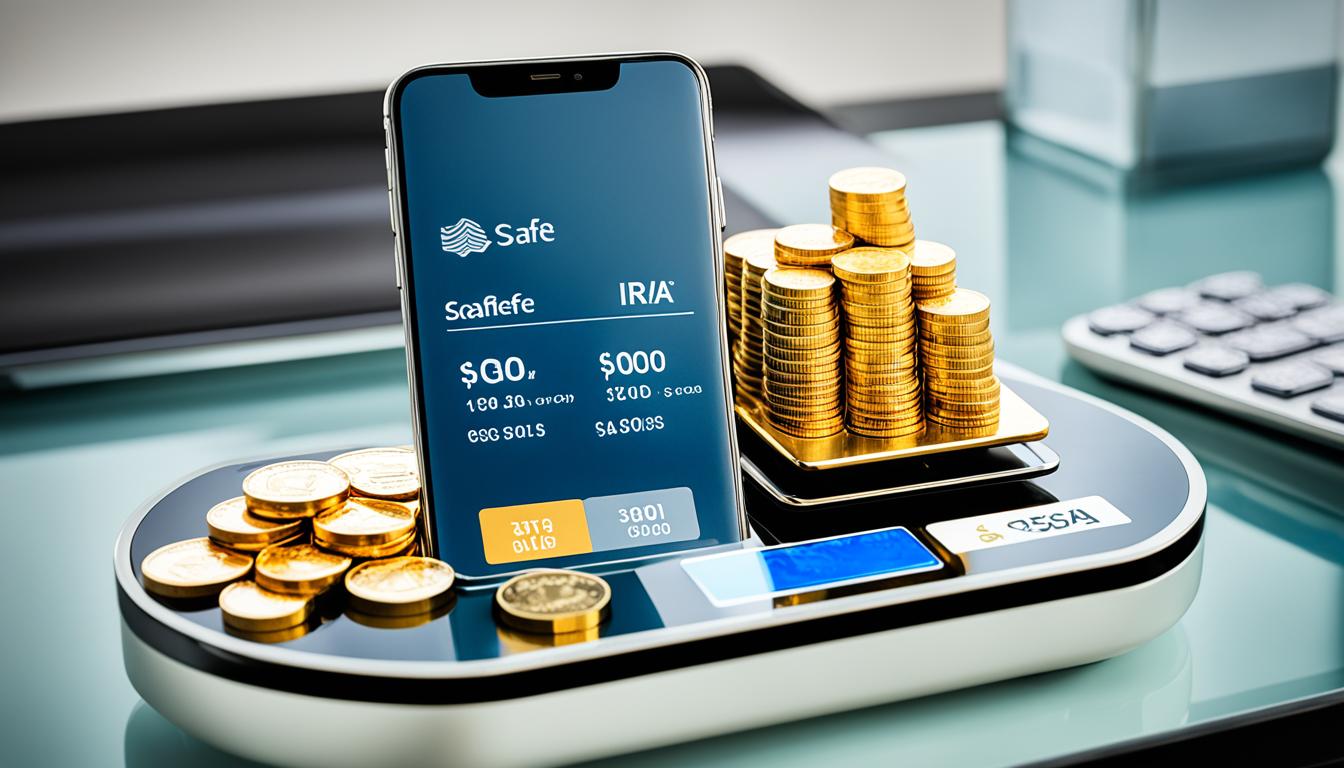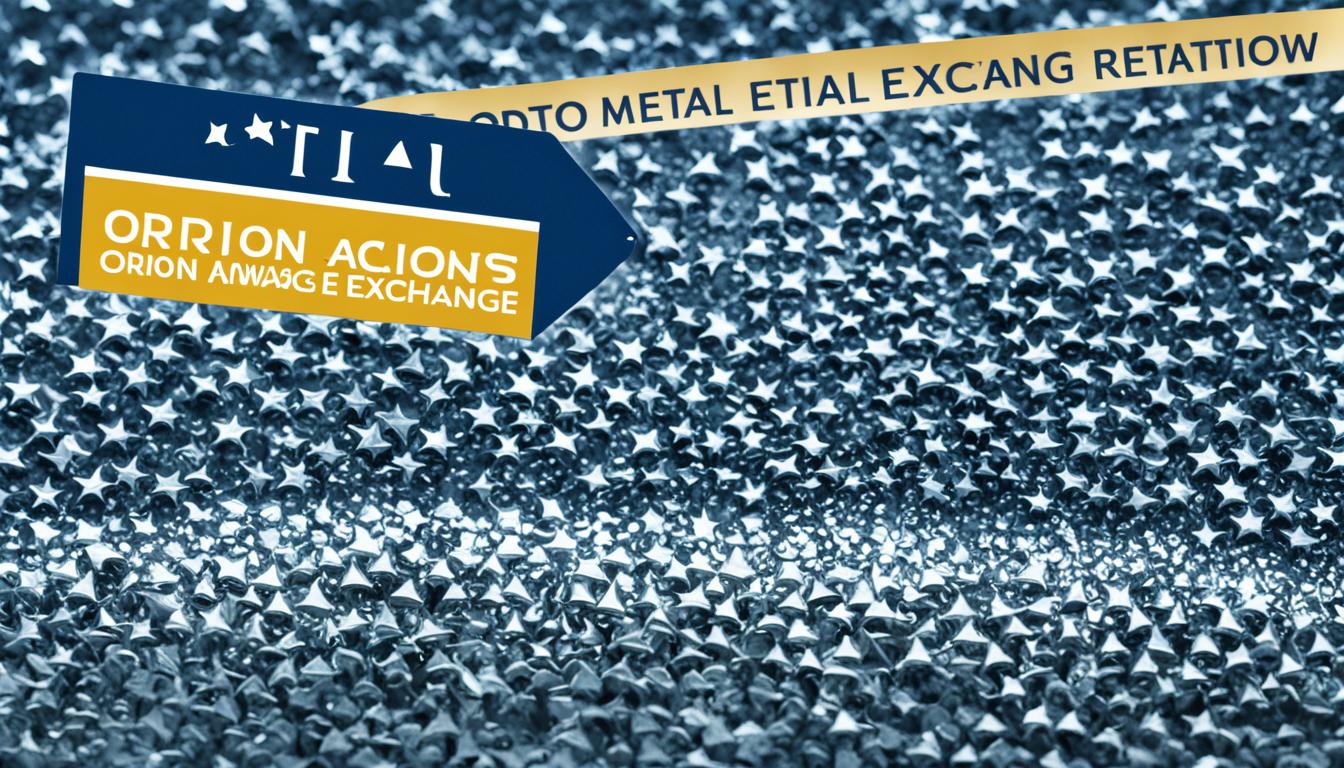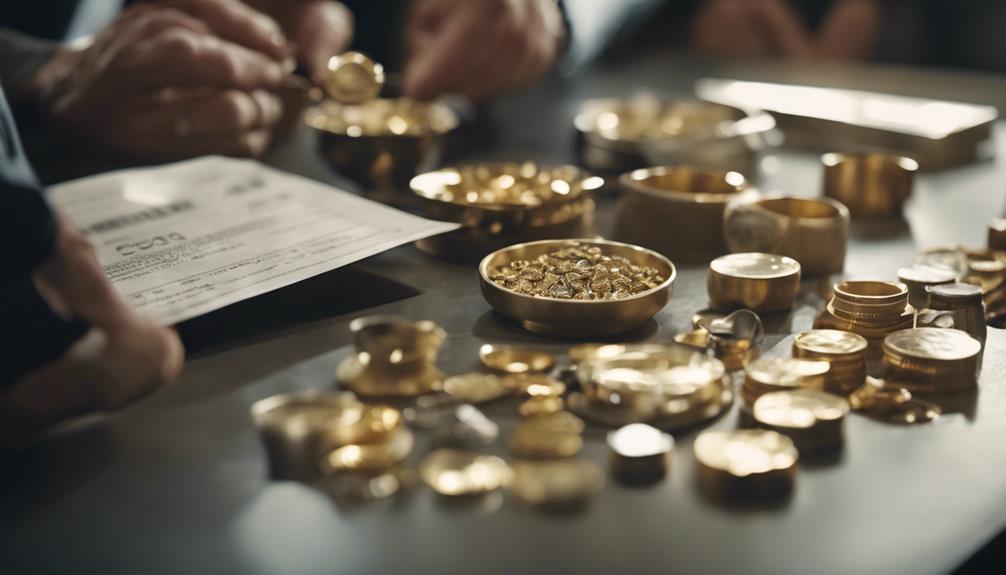Did you know that investing in precious metals can be a key strategy for diversifying your investment portfolio? In fact, savvy investors understand the importance of including precious metals in their investment mix. With the potential for solid returns and a hedge against inflation, precious metals offer unique benefits that can enhance overall investment performance. But how much should you invest in precious metals, and what are the best strategies to maximize your returns?
Key Takeaways:
- Diversifying your portfolio with precious metals can provide a hedge against inflation and potentially enhance overall investment performance.
- Understanding how much to invest in precious metals requires careful consideration of your risk tolerance, investment goals, and market conditions.
- There are various investment options available, including physical precious metals, mining company stocks, exchange-traded funds (ETFs), and individual retirement accounts (IRAs).
- Factors that can influence the price of precious metals include scarcity, natural events, and geopolitical conditions.
- While investing in precious metals offers advantages such as liquidity and portfolio diversification, there are also risks to consider, including price volatility and the performance of mining stocks.
Why invest in precious metals?
Investing in precious metals can provide numerous benefits and opportunities for investors. Precious metals, such as gold, silver, platinum, and palladium, offer a store of value and can serve as a safeguard against economic uncertainties. Furthermore, their industrial uses contribute to a steady demand, potentially enhancing their value.
One of the primary benefits of investing in precious metals is their ability to hold value over time, regardless of economic trends and monetary policies. They are often considered a safe haven during times of economic uncertainty, serving as a hedge against inflation and market volatility. These metals act as a store of value, allowing investors to preserve their wealth.
Beyond their role as a store of value, precious metals have a wide range of industrial uses. They are utilized in various industries such as medicine, automotive, electronics, and renewable energy. For instance, gold is used in electronics and semiconductors, silver is employed in solar panels and antibacterial applications, platinum is used in catalytic converters and fuel cells, and palladium is utilized in catalytic converters and hydrogen storage. The continuous demand for these metals in industrial applications creates a stable market and potential for increased value.
“Investing in precious metals allows individuals to diversify their portfolios, mitigate risks, and potentially benefit from long-term value appreciation.” – Financial Analyst
Moreover, investing in precious metals offers diversification benefits. Precious metals have a low correlation with other asset classes, such as stocks and bonds, meaning that their value movements are often independent of other investments. By adding precious metals to a portfolio, investors can reduce their overall portfolio risk and potentially enhance returns.
To illustrate the industrial uses and benefits of investing in precious metals, the following table showcases the common uses and market demand for gold, silver, platinum, and palladium:
| Precious Metal | Industrial Uses | Market Demand |
|---|---|---|
| Gold | Jewelry, electronics, dentistry, aerospace | High |
| Silver | Electronics, solar panels, medical devices, photography | High |
| Platinum | Automotive catalysts, jewelry, industrial applications | Moderate |
| Palladium | Automotive catalysts, electronics, jewelry | Moderate |
This table demonstrates the diverse range of industrial applications for precious metals and the overall market demand across different sectors.

By investing in precious metals, individuals can benefit from their store of value, industrial uses, and potential for long-term value appreciation. However, it is important to conduct thorough research and consider one’s investment objectives and risk tolerance before making investment decisions.
Types of precious metals
When it comes to investing in precious metals, there are several types that investors commonly consider. Each of these metals has its own unique characteristics and investment potential. Let’s take a closer look at the four major precious metals: gold, silver, platinum, and palladium.
Gold
Gold is perhaps the most well-known and widely traded precious metal. Valued for its durability, malleability, and attractive appearance, gold has been treasured by civilizations throughout history. It is commonly used in jewelry and is also considered a hedge against inflation. The price of gold is influenced by various factors, such as global economic conditions, central bank policies, and geopolitical events.
Silver
Silver is another popular precious metal with a wide range of industrial applications. It is known for its electrical conductivity, making it essential in electronics, solar panels, and batteries. Silver also has antimicrobial properties and is used in the healthcare industry. As a more affordable option compared to gold, silver attracts both investors and collectors alike.
Platinum
Platinum is a rarer precious metal compared to gold and silver. It has important industrial uses, particularly in the automotive industry, where it is used in catalytic converters. Platinum is also valued for its resistance to corrosion and its attractive white color. Due to its scarcity and diverse industrial applications, platinum often carries a higher price tag compared to other precious metals.
Palladium
Palladium is a lesser-known precious metal but still holds significant investment potential. It is primarily used in catalytic converters, similar to platinum. The majority of palladium supply comes from Russia and South Africa, making it subject to geopolitical risks. As demand for palladium continues to rise, particularly in the automotive sector, its price has experienced notable increases in recent years.
| Precious Metal | Overview | Investment Potential |
|---|---|---|
| Gold | Highly valued, widely traded, used in jewelry and as a hedge against inflation | Long-term store of value, potential price appreciation during economic uncertainty |
| Silver | Valued for its industrial applications, more affordable than gold | Price appreciation potential, industrial demand, and store of value |
| Platinum | Rare, important industrial uses, attractive white color | Potential for price appreciation, industrial demand, and scarcity |
| Palladium | Less known, vital for catalytic converters, mined in limited countries | Growing demand in automotive industry, limited supply, potential price gains |
Each precious metal offers unique investment opportunities and potential advantages for investors. Whether you choose gold, silver, platinum, or palladium, it is crucial to carefully consider their market dynamics, industrial uses, and price drivers before making any investment decisions.
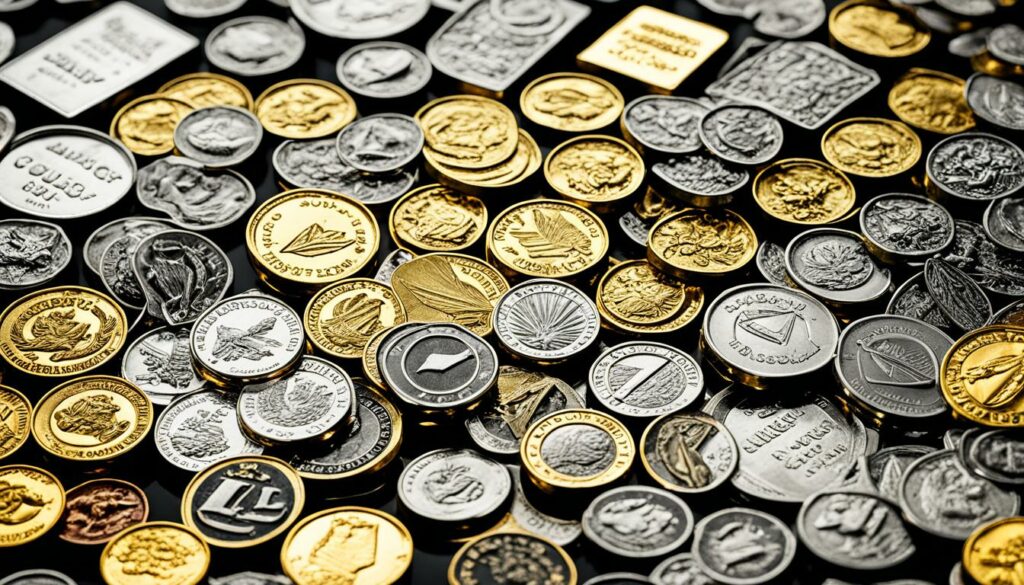
How to invest in precious metals
When it comes to investing in precious metals, there are various options to consider. Here are different investment vehicles that can help you capitalize on the potential of precious metals:
1. Physical Forms: Coins and Bullion
One of the most straightforward ways to invest in precious metals is by purchasing physical forms like coins and bullion. These tangible assets can be stored and held directly, allowing you to have ownership of the precious metal itself.
2. Mining Company Stocks and Mutual Funds
Investing in mining company stocks and mutual funds is another avenue to consider. This allows you to gain exposure to the precious metal industry without having to physically hold the metal. By investing in these stocks, you can potentially benefit from the performance of mining operations and the overall demand for precious metals.
3. Exchange-Traded Funds (ETFs)
Exchange-traded funds (ETFs) provide an easy and convenient way to gain exposure to precious metals. These funds hold physical metals or stocks of mining and production companies. By purchasing shares of ETFs, you can indirectly invest in precious metals while benefiting from diversification.
4. Futures Contracts
Futures contracts are suitable for experienced investors willing to take on higher risk. In futures trading, you can speculate on the future price of precious metals without owning the underlying asset. This type of investment can offer greater leverage and potential returns, but it is also accompanied by increased risk.
5. Individual Retirement Accounts (IRAs)
If you’re thinking about long-term retirement savings, individual retirement accounts (IRAs) can be an excellent option. Some IRAs allow you to invest in precious metals as part of your portfolio, offering potential growth and security for your retirement years.
Each investment option has its own advantages and considerations. It’s crucial to assess your investment goals, risk tolerance, and financial situation before deciding which approach aligns best with your objectives.
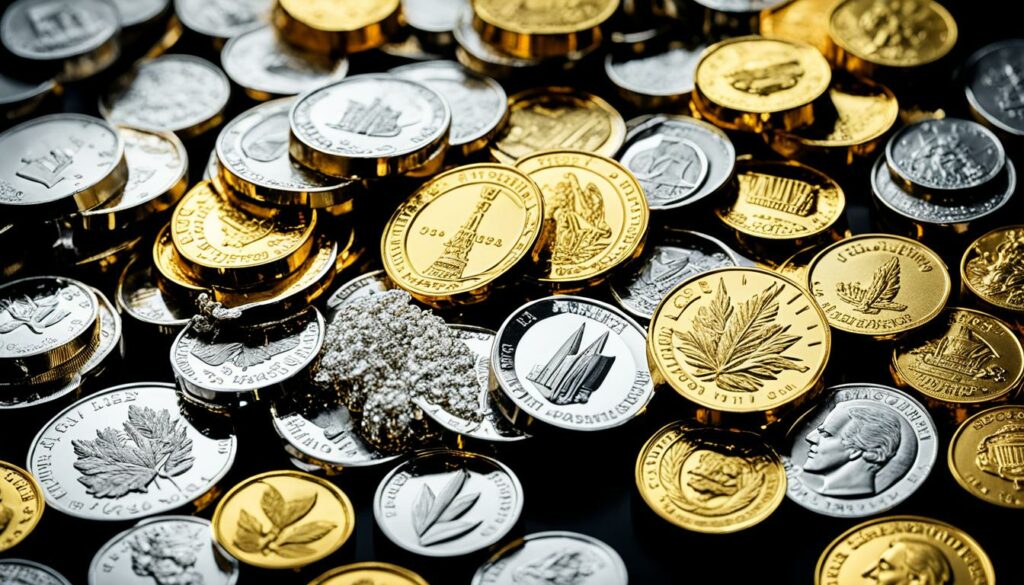
Understanding the diverse investment options available enables you to tailor your strategy to fit your unique needs and preferences. Whether you choose to buy physical metals, invest in mining company stocks, or explore other investment vehicles, precious metals can play a valuable role in diversifying your investment portfolio and potentially generating long-term returns.
Factors affecting precious metals prices
Precious metals prices are influenced by various factors that investors should consider when evaluating the potential price movements of these valuable commodities. Understanding these factors can help investors make more informed decisions and manage their precious metals investments effectively.
Scarcity and Availability
Scarcity and availability play a significant role in determining the prices of precious metals. These metals, such as gold, silver, platinum, and palladium, are finite resources with limited availability, making them inherently valuable. The rarity of these metals contributes to their desirability and can drive up their prices as demand increases.
Natural Events
Natural events can have a significant impact on the prices of precious metals. Geological events such as earthquakes, hurricanes, and floods can disrupt mining operations and affect the supply of precious metals. This disruption in supply can lead to price fluctuations as the market adjusts to the changing availability of these metals.
Geopolitical Conditions
Geopolitical conditions also influence the prices of precious metals. Political crises, conflicts, and trade policies can disrupt the global supply chain and impact the supply and demand dynamics of precious metals. Instances of political instability can create uncertainty in the market, causing prices to fluctuate as investors react to changing conditions.
By considering these factors, investors can gain valuable insights into the potential price movements of precious metals. It is important to stay informed about global events, geopolitical developments, and market trends to make well-informed investment decisions.
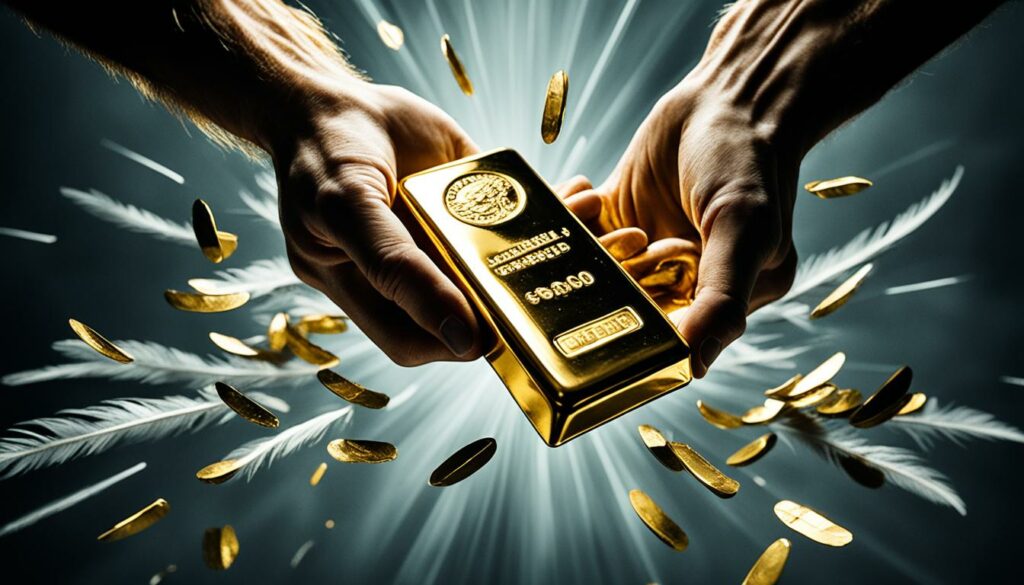
Advantages and disadvantages of investing in precious metals
Investing in precious metals offers several advantages that can be beneficial for investors looking to diversify their portfolios and protect their wealth. However, there are also some disadvantages that should be considered. Let’s explore the advantages and disadvantages of investing in precious metals.
Advantages of Investing in Precious Metals
Precious metals as a hedge against inflation: Investing in precious metals, such as gold and silver, can serve as a hedge against inflation. Gold and silver prices tend to rise with or above the inflation rate, preserving the purchasing power of your investment. During periods of high inflation, the value of precious metals can increase, providing a safeguard for your wealth.
Tangible assets with inherent value: Precious metals are tangible assets that hold inherent value. Unlike stocks or bonds, which can be influenced by market sentiment and fluctuating economic conditions, precious metals have a physical presence and are not reliant on the performance of any particular company or government. This tangible nature gives investors a sense of security and stability.
Liquidity: Precious metals offer liquidity, meaning they can be easily bought and sold on various platforms and exchanges. When you invest in physical precious metals, such as gold or silver coins, you have the option to sell them quickly and convert them into cash when needed. This liquidity provides flexibility and accessibility to your investment.
Portfolio diversification: Investing in precious metals can help diversify your investment portfolio. Precious metals often have a low or negative correlation with other asset classes, such as stocks and bonds. This means that when other investments are experiencing volatility or declining in value, the value of precious metals may remain stable or even increase. By incorporating precious metals into your portfolio, you can potentially reduce overall risk and volatility.
Disadvantages of Investing in Precious Metals
Costs of storing and insuring physical metals: If you choose to invest in physical precious metals, such as coins or bars, you will need to consider the costs of storing and insuring them. Storing precious metals securely can come with additional expenses, such as safety deposit boxes or secure vaults, to protect your investment from theft or damage.
Potential for theft: Physical precious metals can be susceptible to theft. While storing them securely can mitigate this risk, it’s essential to be aware that there is always a possibility of loss or theft when holding physical assets.
Lack of income generation: Unlike some other investment options, investing in precious metals does not generate regular income. While the value of precious metals may appreciate over time, you won’t receive dividends or interest payments like you would with stocks or bonds.
Overall, investing in precious metals can provide several advantages, including a hedge against inflation, tangible asset ownership, liquidity, and portfolio diversification. However, it’s important to consider the potential disadvantages, such as the costs of storage and insurance, the risk of theft, and the lack of income generation. By carefully weighing these pros and cons, you can make informed decisions about incorporating precious metals into your investment strategy.
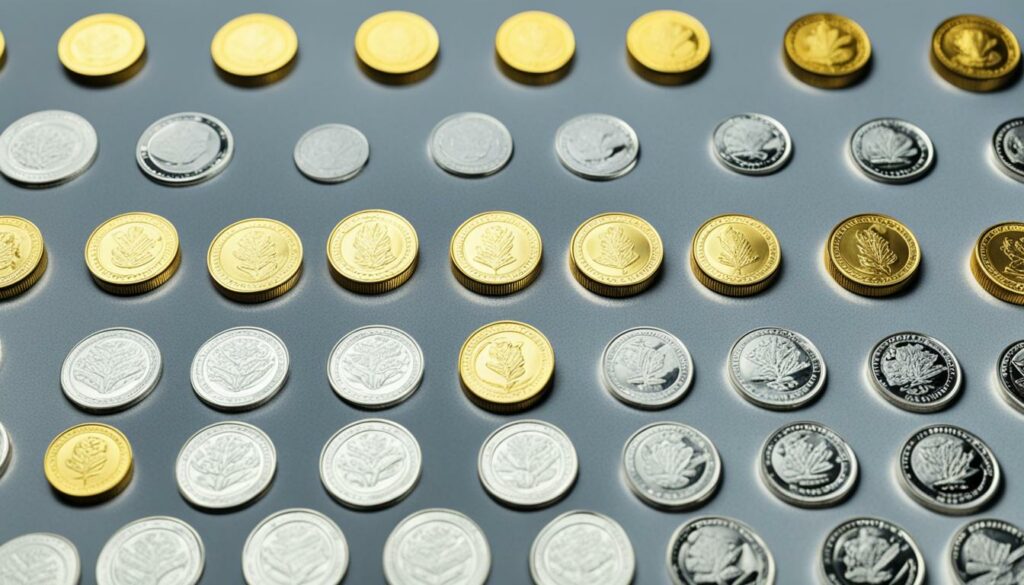
Risks of investing in precious metals
While investing in precious metals can offer various benefits, it is important for investors to be aware of the inherent risks associated with this asset class.
Price Volatility
One of the significant risks of investing in precious metals is price volatility. The prices of precious metals, including gold, silver, platinum, and palladium, can fluctuate due to various factors such as economic conditions, supply and demand dynamics, and geopolitical events. These price fluctuations can impact the value of investors’ portfolios and may lead to potential losses if not managed effectively.
Performance of Mining Stocks
Investors who choose to invest in precious metals through mining stocks should be aware of the volatility in the performance of these stocks. While mining stocks are often correlated with the price of the underlying precious metal, they can also be influenced by other factors such as operational challenges, management decisions, and overall market sentiment. This volatility in mining stocks’ performance may not always align with the expected movements in the price of the precious metal, potentially resulting in unexpected outcomes for investors.
Correlation with the Stock Market
Precious metals, particularly mining stocks, may also have a correlation with the overall stock market. During market downturns, when stock prices decline, there is a possibility that the value of precious metals and related stocks may also be negatively impacted. This correlation can result in potential losses for investors who expected a divergence between the stock market and the performance of precious metals.
Impact of Cryptocurrencies
The rise of cryptocurrencies as alternative investment assets has the potential to impact the demand for precious metals and subsequently affect their prices. While precious metals have traditionally been considered a safe haven and store of value, the emergence of digital currencies has introduced new investment options and alternatives. The impact of cryptocurrencies on the demand for precious metals is still evolving, and investors should carefully consider the potential implications on their investments.
It is important for investors to thoroughly research, analyze market trends, and consult with financial professionals to understand and mitigate these risks when investing in precious metals. By being well-informed and proactive, investors can navigate the challenges and make informed decisions to maximize the potential benefits of investing in precious metals.
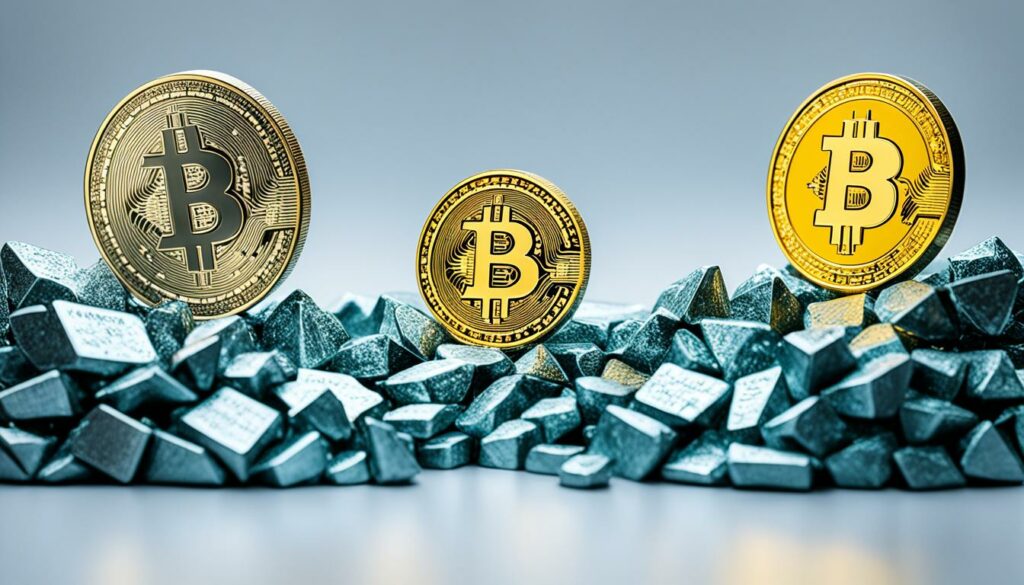
How to invest in precious metals
Investing in precious metals offers various avenues for individuals to diversify their investment portfolios and potentially capitalize on the value and market dynamics of these valuable assets. There are two primary methods to invest in precious metals: through physical purchases of precious metals or through investment products.
Physical Precious Metals
One way to invest in precious metals is by acquiring physical forms of these metals. This can include purchasing bars, coins, or jewelry made from gold, silver, or platinum. Physical metals provide tangible assets that investors can hold, store, and potentially sell at a later time. Additionally, owning physical precious metals allows for direct ownership and control over the asset.
“Investors can choose from a wide range of physically backed investment products, including ETFs, mutual funds, and futures contracts, to gain exposure to different precious metals and the precious metal industry.”
When investing in physical precious metals, it is important to consider the costs associated with storage and insurance. Storing valuable metals securely is crucial to protect the investment from theft or damage, and insurance coverage provides additional peace of mind.
Investment Products
Investment products present another avenue for individuals to access the potential benefits of precious metals investing. These products offer exposure to precious metals without the need for physical ownership. Some popular investment products include:
- Exchange-Traded Funds (ETFs) and Mutual Funds: Investors can choose from a wide range of physically backed investment products, including ETFs and mutual funds, to gain exposure to different precious metals and the precious metal industry. These funds hold portfolios of physical metals or shares of mining and production companies.
- Futures Contracts: More experienced investors can engage in the futures market by trading contracts that represent a specified quantity of gold, silver, or platinum. Futures contracts allow for potential profit from price movements without the need for physical ownership of the metal.
Another option for investing in precious metals is focusing on specific mining companies that extract gold, silver, or platinum. Investing in stocks of these mining companies provides exposure to the precious metals sector and the potential for capital appreciation based on the performance of the company and the underlying metal’s price.
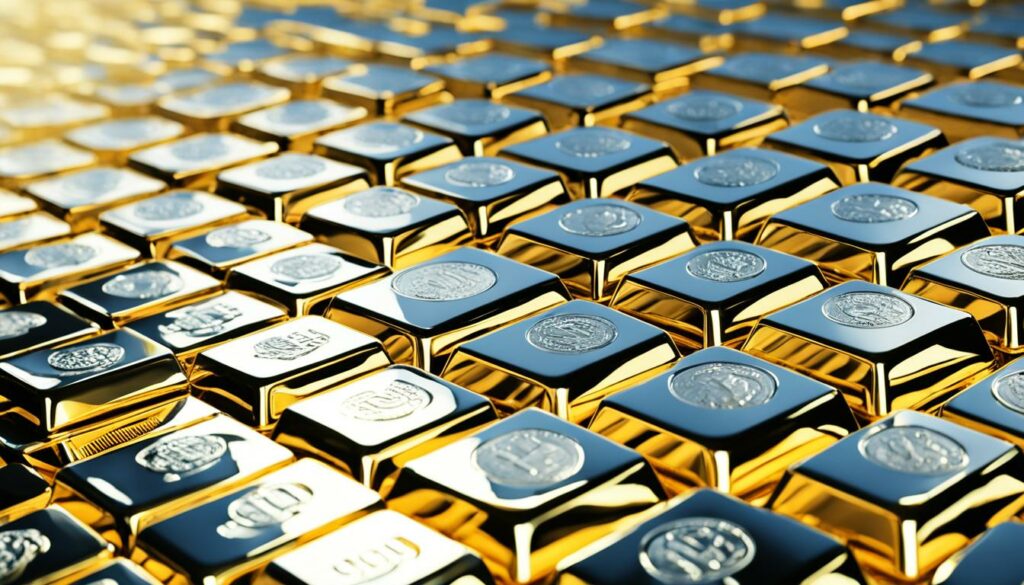
Investors should carefully evaluate their investment goals, risk tolerance, and investment time horizon before choosing the most suitable investment method for their precious metals investment.
Best precious metals to invest in
When considering specific investments in precious metals, there are several stocks that investors could consider.
| Company | Focus |
|---|---|
| First Majestic Silver | Silver and gold mining |
| Franco-Nevada | Gold-focused royalty and streaming |
| Newmont Mining | Largest gold mining company |
| Sibanye-Stillwater | Producer of platinum group metals (PGMs) and gold |
| Wheaton Precious Metals | Precious metals streaming |
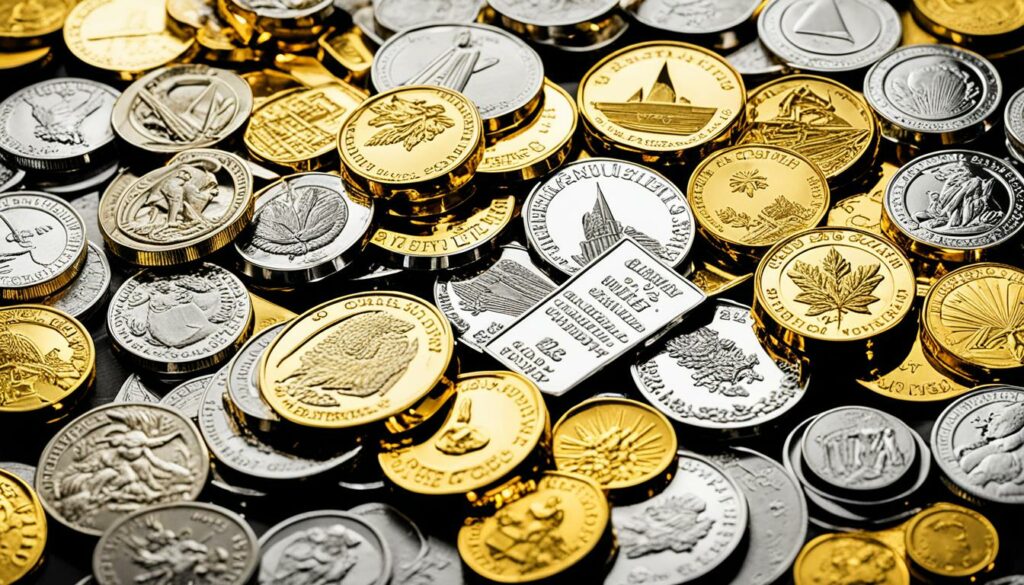
First Majestic Silver is a silver and gold mining company that offers exposure to the price of silver. Franco-Nevada is a leading gold-focused royalty and streaming company. Newmont Mining is the largest gold mining company in the world and produces other basic materials. Sibanye-Stillwater is a major producer of platinum group metals (PGMs) and gold, with investments in metals used for electric vehicle batteries. Wheaton Precious Metals is one of the world’s largest precious metals streaming companies, generating revenue from gold, silver, palladium, and cobalt.
Conclusion
Investing in precious metals can be a valuable addition to a well-diversified portfolio. Precious metals offer numerous benefits, including acting as a hedge against inflation, providing tangible assets, offering liquidity, and contributing to portfolio diversification.
However, it is important to note that there are risks associated with investing in precious metals. Price volatility, the performance of mining stocks, and correlation with the stock market can all impact the returns on precious metals investments. Additionally, the rise of cryptocurrencies as alternative investment assets may have an influence on the demand and prices of precious metals.
Before making investment decisions, investors should carefully consider their investment objectives, risk tolerance, and the specific dynamics of the precious metals market. This will help them navigate the potential advantages and risks associated with investing in precious metals, allowing them to make informed decisions and optimize their portfolios.

